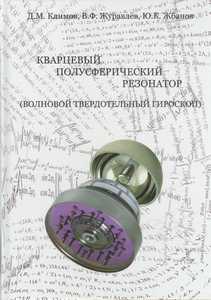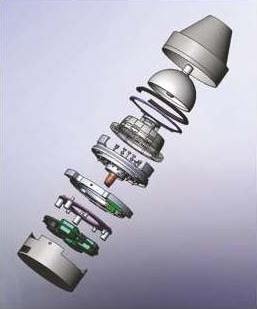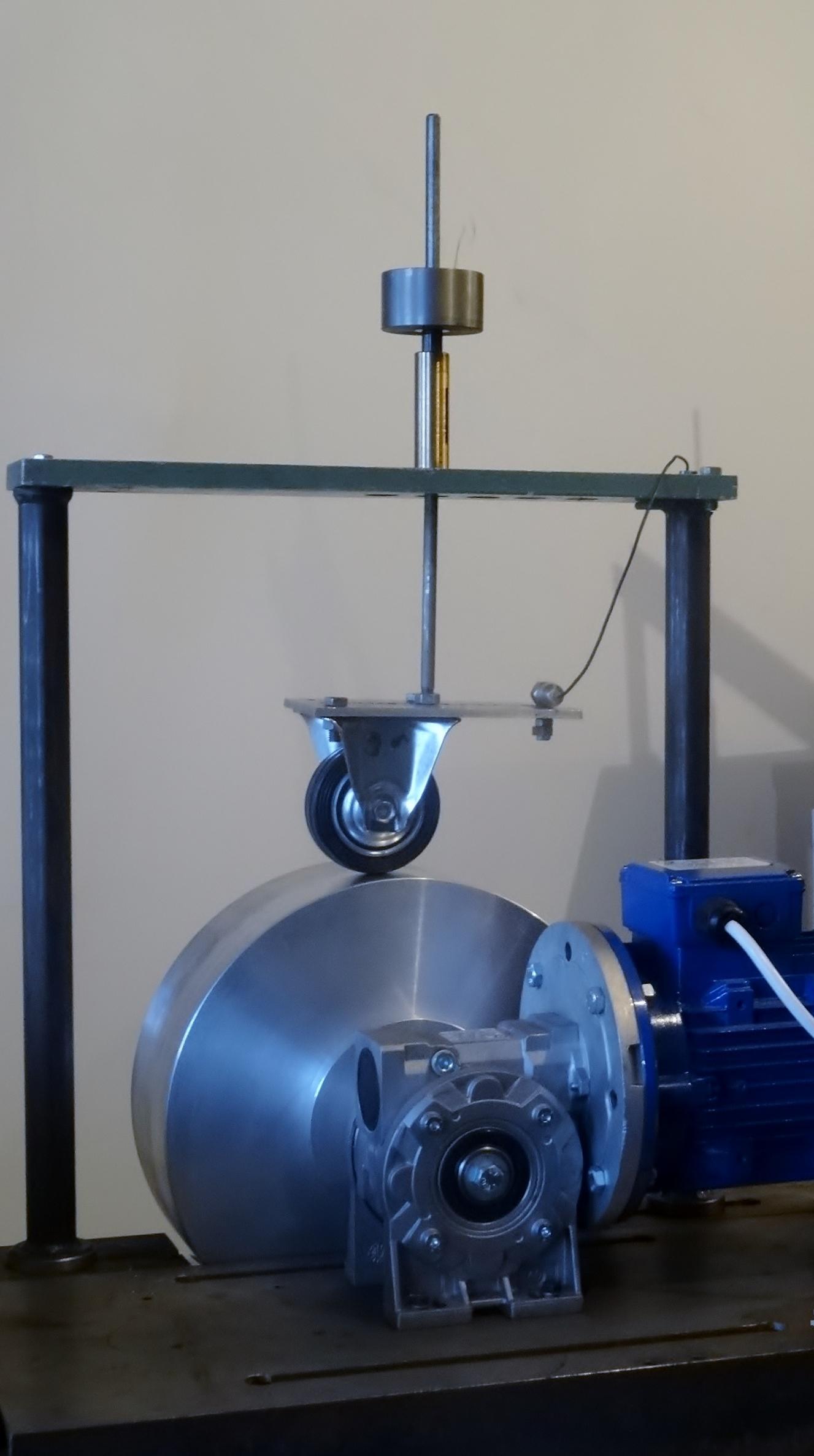Laboratory of Mechanics of Systems. Details
Main achievements
Since 1982, the Laboratory has been studying a new type of gyro, a hemispherical resonator gyro, which uses the properties of a standing wave in an elastic ring or in a thin elastic shell of hemispherical or other axisymmetric shape. It was shown that a standing elastic vibration wave excited in the ring or the thin elastic shell (referred to as the resonator) has the remarkable property that its angular velocity relative to the instrument casing attached to the base is proportional to the angular velocity of the base relative to the inertial space. The proportionality coefficient is strictly preserved under an arbitrary time dependence of the projection of the angular velocity onto the symmetry axis of the resonator. A detailed theory of the instrument is presented in two monographs.

Zhuravlev V.Ph., Klimov D.M.
Wave solid-state gyroscope.
Ìoscow: Nauka, 1985. 126 p. (in Rissian)
Klimov D.M., Zhuravlev V.Ph., Zhbanov Yu.K.
Quartz hemispherical resonator (wave solid-state gyroscope).
Moscow: "Kim L.A." publishing, 2017. 194 p. (in Rissian)
Deep research is carried out by the Laboratory on Hamiltonian systems and dynamics of solids. A modified method of asymptotic symmetrization of Hamiltonians have been developed for integrating Hamiltonian systems.
To analyze the motion of simple viscous media, a numerical saturation-free boundary element method has been devised. The error of the method decays more rapidly than any power of the mesh width. The method has been applied to the design and optimization of the hydro turbine blade shape.
The Laboratory has analyzed the dry friction forces in rigid body contact regions. A new body interaction model determined by dry friction forces has been constructed. It is assumed in the model that the classical Coulomb law holds in a small neighborhood of every point in the body contact region and that the force interaction is determined by the corresponding integral over the entire contact region. The studies have shown that this new interaction model provides results dramatically different for earlier-obtained ones in many problems where it was thought that the interaction of the bodies can be reduced to nonholonomic constraints. The new model has provided an explanation for the unusual properties of the motion of the Celtic stone and the toy tip top.
New results have been obtained in the analysis of the wheel shimmy phenomenon (aircraft undercarriage wheel vibrations at takeoff and landing). Well-known studies carried out in Russia and abroad suggest that shimmying is caused by deformation of the rubber tires. The new model of contact interaction of bodies shows that shimmying may well arise even if the wheel is a rigid (undeformable) body.

Shimmy model
General information

Dmitry M.
Klimov
Academician
Head of the Laboratory
in 1967-1989
Director of the Institute
in 1989-2004
Victor Ph.
Zhuravlev
Academician
Head of the Laboratory
in 1989-1992
Yury K.
Zhbanov
D.Sc., Professor
Head of the Laboratory
in 1992-2012
Sergey A.
Reshmin
Corresponding Member of RAS
Head of the Laboratory
since 2012
History
Academician Dmitry M. Klimov was the first to head the Laboratory of Mechanics of Systems. His vast practical experience as a designer of gyro missile control systems and deep insight into gyro theory helped him to set up a number of interesting and useful activities and form a capable team of highly qualified researchers. One of them, V.Ph. Zhuravlev (who is presently Full Member of the Russian Academy of Sciences) managed to solve the problem, very topical at the time, of finding a sharp estimate for the fixed drift of a gyro perfectly suspended in three gimbals (known as the Magnus drift). The very fact that a perfectly balanced gyro under total absence of friction can experience drift seemed to be paradoxical. V.Ph. Zhuravlev explained the drift by taking into account the moments of inertia of the rings in the gimbal suspension when studying the nutation vibrations of the gyro rotor.
At that time, each and every gyro instrument included a gimbal gyro, a ball bearing being one of the most important part of the gimbal suspension. The instrument precision depended substantially on the quality of the bearings and the suspension as a whole. Studies aimed at solving many practical problems arising in gyro engineering were carried out in the Laboratory.
In the early 1970s, Yuri K. Zhbanov, who had earlier worked at the Instrument Engineering Institute of the Ministry for Ship-building Industry, joined the Institute for Problems in Mechanics. He actively participated in the development of the navigation assembly for the Soviet tracking ship "Kosmonavt Yuri Gagarin." The Laboratory carried out a number of projects under contracts with navigation equipment manufacturing enterprises, including the development of a standard algorithm for prelaunch calibration of the gyro platform of a submarine-based missile and part of the software for the navigation equipment of the submarine itself. This software was the first on the Russian fleet to implement the Kalman filter. On the order of the engineers of the "Igla" anti-tank missile, its gyro stabilization system was analyzed in the Laboratory, and a way to provide its stability was found (which the engineers themselves had not been able to do).

Hemispherical resonator gyro scheme
Resonator of hemispherical resonator gyro
Awards
- Klimov D.M.
- Zhuravlev V.Ph.
- Lenin Komsomol prize (1976)
- Order of the Badge of honor (1982)
- State prize (1994)
- Zhbanov Yu.K.
- Markeev A.P.
- A minor planet is named in honor of A.P. Markeev: 4302 Markeev (1992)
- State prize (1994)
- Lyapunov prize of the Russian Academy of Sciences (2013)
- Petrov A.G.
- S.A. Chaplygin Golden Medal (2020)
- Reshmin S.A.
- New generation award of RAO UES of Russia and RAS (2005)
- Andronov prize of the Russian Academy of Sciences (2015)
Main publications
Books
- Klimov D.M., Zhuravlev V.Ph. Group-Theoretic methods in mechanics and applied mathematics. London and New York: Taylor&Francis, 2002, 302 p. ISBN 978-0-4152-9863-6
- Klimov D.M., Zhuravlev V.Ph., Zhbanov Yu.K. Quartz hemispherical resonator (wave solid-state gyroscope). Moscow: "Kim L.A." publishing, 2017. 194 p. ISBN 978-5-9909668-5-7 (in Russian)
- Zhuravlev V.Ph., Klimov D.M.
Wave solid-state gyroscope. Ìoscow: Nauka, 1985. 126 p. (in Rissian)
Papers
- Reshmin S.A. The analysis of the loss of the traction effect during an intensive start of a vehicle // Journal of Computer and Systems Sciences International. 2019. Vol. 58. No. 3. P. 349-359. DOI: 10.1134/S1064230719030171
- Reshmin S.A. Threshold absolute value of a relay control when time-optimally bringing a satellite to a gravitationally stable position // Journal of Computer and Systems Sciences International. 2018. Vol. 57. No. 5. P. 713-722. DOI: 10.1134/S106423071805012X
- Reshmin S.A. Properties of the time-optimal control for Lagrangian single-degree-of-freedom systems // IEEE Transactions on Automatic Control. 2015. Vol. 60. No. 12. P. 3350-3355. DOI: 10.1109/TAC.2015.2422477
- Zhuravlev V.Ph., Klimov D.M. Theory of the Shimmy Phenomenon // Mech. Solids. 2010. Vol. 45. No. 3. P. 324-330. DOI: 10.3103/S0025654410030039
- Zhuravlev V.Ph. On Plane Self-Excited Vibrations of a Cantilever Suspended Wheel // Mech. Solids. 2012. Vol. 47. No. 2. P. 155-159. DOI: 10.3103/S002565441202001X
- Zhuravlev V.Ph., Klimov D.M., Plotnikov P.K. A New Model of Shimmy // Mech. Solids. 2013. Vol. 48. No. 5. P. 490-499 DOI: 10.3103/S0025654413050026
- Markeev A.P. On Nonlinear Resonant Oscillations of a Rigid Body Generated by Its Conical Precession // Russian Journal of Nonlinear Dynamics. 2018. Vol. 14. No. 4. P. 503-518. DOI: 10.20537/nd180406
- Markeev A.P. On the Stability of Steady Rotation of a Satellite around the Normal to the Orbital Plane // Mech. Solids. 2020. Vol. 55. No. 7. P. 29-39. DOI: 10.3103/S0025654420070146
- Markeev A.P. On Periodic Poincare' Motions in the Case of Degeneracy of an Unperturbed System // Regular and Chaotic Dynamics. 2020. Vol. 25. No. 1. P. 111-120. DOI: 10.1134/S1560354720010098
- Markeev A.P. Action-Angle Variables in a Particular Case of the Restricted Three-Body Problem // Doklady Physics. 2020. Vol. 65. No. 1. P. 103-108. DOI: 10.1134/S1028335820030118
- Petrov A.G. Exact solution of the equations of axisymmetric viscous fluid flow between parallel plates approaching and moving apart from one another // Fluid Dynamics. 2019. Vol. 54. No. 1. P. 56-66. DOI: 10.1134/s0015462819010105
- Baykov N.D., Petrov A.G. On the plane-parallel motion of self-gravitating and rotating incompressible fluid with a free boundary // European Journal of Mechanics, B/Fluids. 2019. Vol. 78. P. 150-160. DOI: 10.1016/j.euromechflu.2019.06.011
- Petrov A.G. Numerical schemes without saturation for periodic functions // Doklady Mathematics. 2018. Vol. 98. No. 1. P. 348-352. DOI: 10.1134/S1064562418050150
- Maklakov D.V., Petrov A.G. On steady non-breaking downstream waves and the wave resistance – Stokes' method // Journal of Fluid Mechanics. 2017. Vol. 815. P. 388-414. DOI: 10.1017/jfm.2017.62
- Zhbanov Yu.K., Privalov E.A. Rod construction of an isotropic elastic suspension of inertial mass // Mech. Solids. 2018. Vol. 53, No. 5. P. 492-500. DOI: 10.3103/S0025654418080034
Experimental equipment
- Installation for demonstration and study of the shimmy phenomenon, year of creation: 2013,
year of modification: 2019.

Installation for demonstration
and study of the shimmy phenomenon
The phenomenon of azimuthal self-oscillation of aircraft wheels, called shimmy, is known from the very beginning of aviation. It is the cause of serious accidents and hundreds of researchers around the world have devoted their research to it. In our country, academician M.V. Keldysh received the Stalin prize for his work on shimmy theory in 1946. The Keldysh model is based on two hypotheses: the Rocard withdrawal hypothesis, which describes the deformation of the pneumatic, and the hypothesis of no slippage at the point of contact of the pneumatic with the landing strip (a non-holonomic condition). Other researchers use the same hypotheses.
At the Ishlinsky Institute of problems of mechanics of the Russian Academy of Sciences, in the laboratory of mechanics of systems, a new shimmy theory was created, which rejected both of these hypotheses. The pneumatician interacts with the road by means of dry friction forces, and in accordance with the theory of multicomponent dry friction, which generalizes Coulomb's law for non-one-dimensional, non-translational motion, it is impossible to avoid slippage in the case of azimuthal vibrations. Thus, the non-holonomic condition is a false hypothesis. This was established in 1894 by N.E. Zhukovsky (the Zhukovsky effect). The use of the theory of multicomponent dry friction, which was developed at the end of the last century, made it possible to create an adequate shimmy model. The necessary and sufficient conditions for the loss of stability of straight-line rolling of the wheel are obtained, expressed in terms of the actual parameters of the wheel and the strut. In the laboratory of systems mechanics, an experiment was performed that confirms the theoretical assumptions. In particular, it is shown that shimmy occurs not only in the case of rubber wheels (pneumatic), but also for plastic and metal.
- Viscous-plastic media mixing instrument, year of creation: 2004.

Viscous-plastic media mixing instrument
At the Laboratory, unique experimental and test facility have been built for the studies of dispersive viscoplastic media, which are a very complicated object from the viewpoint of mechanics. The studies are aimed at new promising technologies in food and pharmaceutical industry.
